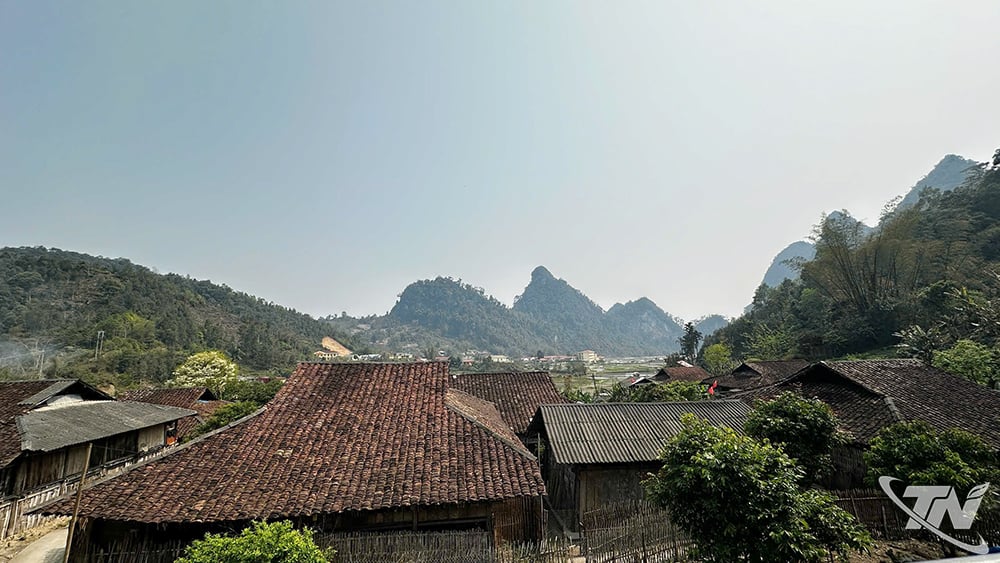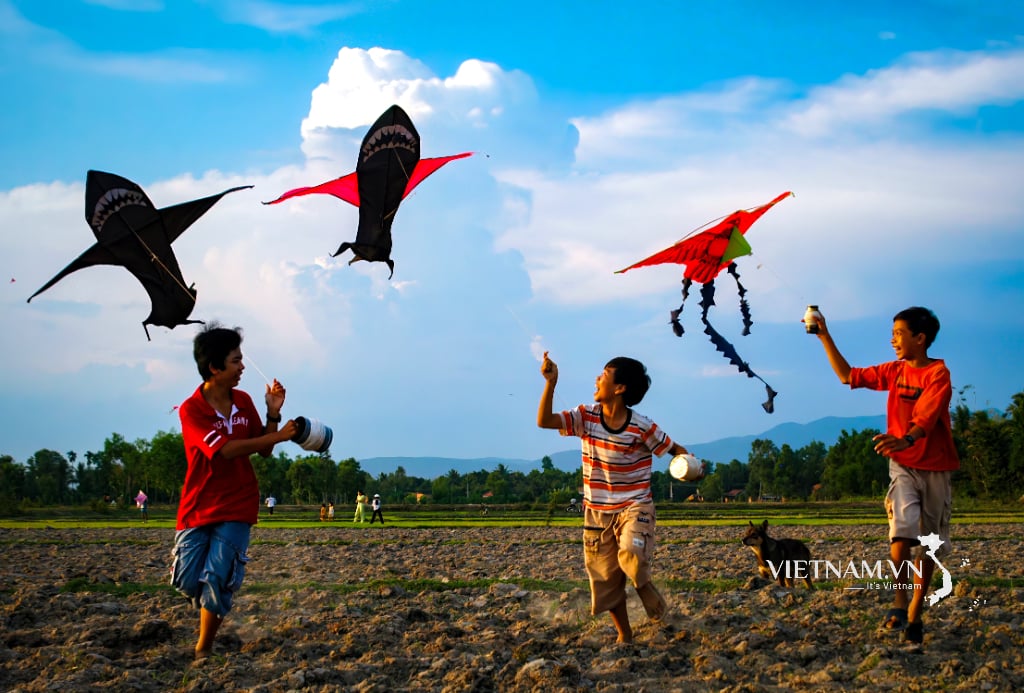 |
| Mossy yin-yang tiled roofs of stilt houses in Van Lang commune. |
In Quoc Tuan village, Van Lang commune, stilt houses lie quietly along the foot of Phja Cam mountain, facing Ban Than field, creating a peaceful scene full of local character.
In the midst of that scene, the stilt house of Mr. Nguyen Duy Am, 90 years old, stands out - a typical example of Tay architecture and culture. Built more than 200 years ago, the house is not only a legacy of Mr. Am's family but also a witness to a cultural region. Through many generations, the house still retains its original structure. All the pillars, beams, rafters, and walls are made of ironwood, the roof is covered with yin-yang tiles made by the local people themselves - all remain intact through many rainy and sunny seasons.
According to Mr. Am, the house has an area of about 150 square meters, divided into four main rooms, one side room and two left rooms. The interior architecture is arranged in the traditional style of the Tay people. The center of the house is a square fireplace that keeps the warmth and is considered the most sacred space.
The living area is located in a position called “na nua”, above the fireplace and next to the altar. Household items such as food cabinets, cupboards, rice jars, etc. are arranged along both sides of the house. The house has seven wooden stairs leading to the floor where four generations of the family live.
According to Mr. Am, the stilt house is not only a place to live but also a place to preserve family memories and family traditions. Every corner of the house is associated with memories of daily activities, rituals, and other important events. Although life has changed, under that roof, generations continue to maintain order, solidarity, and love.
Currently, in Quoc Tuan and Na Mo villages, Van Lang commune, there are still more than 20 stilt houses that are dozens, even hundreds of years old.
 |
| The stilt house is both a living space and a place to preserve family memories and clan traditions. |
For the Tay people, the stilt house is a place to pass on life values, a space to teach children to love, preserve morality and national identity. Stories about ancestors, rituals, and human morality are still passed down through words, actions and daily life.
The traditional Tay stilt house in Van Lang is divided into three main areas, with the hearth in the middle of the house as the center. The space of the house is not only convenient but also reflects the concept of living in harmony with nature. In the summer, the house is always cool; in the rainy season, the high floor helps to avoid humidity; in the winter, the warmth from the hearth spreads throughout the space.
Mr. Nong Thiem Tiem (73 years old), a resident of Quoc Tuan village, said: The stilt house helps the Tay people maintain a lifestyle close to nature, creating a space for solidarity among family members. My family often gathers around the fire. We preserve the ancestral roof as an inseparable part of the village.
Despite their special cultural value, many traditional stilt houses are now being gradually replaced by modern concrete houses, due to convenience, repair costs or deterioration over time. This situation puts the architectural identity and cultural space associated with the traditional lifestyle at risk of being lost.
Ms. Hoang Minh Nhuan, an expert from the Department of Culture and Society of Van Lang commune, said: The ancient stilt houses in the locality not only follow traditional architectural patterns, but also strongly reflect national beliefs and identity.
This is not only a familiar image of the village, but also a valuable resource for developing community tourism. Visitors to Van Lang are delighted to experience life in a stilt house, enjoy Then singing and traditional cuisine .
 |
| Tay women in traditional costumes next to ancient stilt houses. |
In many families, the lifestyle associated with the stilt house is still maintained, especially by the hands of women. They pound green rice cakes, hang meat on the kitchen loft, practice Then singing on the Tinh instrument. Children are also taught how to light the fire, clean the house, preserve food, etc. These simple actions are the way to nurture the lifestyle, preserve the thoughts and feelings associated with the traditional roof from generation to generation.
The stilt house space in Van Lang commune is not only a physical structure, but also a place that contains the spiritual depth of the Tay people. From lullabies, songs to each step on the old stairs, all blend into a continuous cultural flow. Many people share that they cannot remember exactly when the house they are living in was built, only knowing that it has stood here since the time of their ancestors - as a vivid, irreplaceable part of memory.
Amidst the modern hustle and bustle, moss-covered stilt houses with yin-yang tiled roofs still stand proudly in the middle of the forest. Every autumn, amid the smoke from the kitchens drifting on the hillsides, Then singing echoes among the ancient roofs, continuing the journey of preserving the Tay identity in the vast mountains and forests...
Source: https://baothainguyen.vn/van-hoa/202508/duoi-mai-nha-san-ky-uc-khong-ngu-quen-43c1864/





























![[Photo] Nghe An: Provincial Road 543D seriously eroded due to floods](https://vphoto.vietnam.vn/thumb/1200x675/vietnam/resource/IMAGE/2025/8/5/5759d3837c26428799f6d929fa274493)






































































Comment (0)